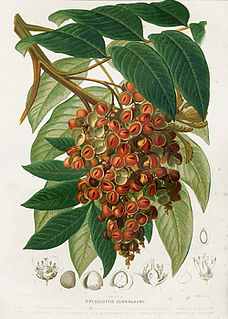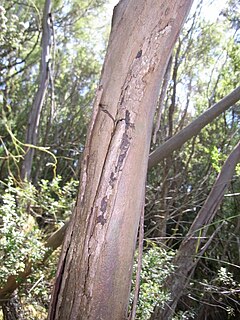Related Research Articles

Allan Cunningham was an English botanist and explorer, primarily known for his travels in Australia to collect plants.

Telopea speciosissima, commonly known as the New South Wales waratah or simply waratah, is a large shrub in the plant family Proteaceae. It is endemic to New South Wales in Australia and is the floral emblem of that state. No subspecies are recognised, but the closely related Telopea aspera was only recently classified as a separate species.

Diploglottis is a genus of 10 species of trees known to science, constituting part of the plant family Sapindaceae. They grow naturally in rainforests and margins of adjoining humid forests in eastern Australia and New Guinea. Some species are known as native tamarind or small-leaved tamarind; they have no direct relationship with the true tamarind.

Nancy Tyson Burbidge was an Australian systemic botanist, conservationist and herbarium curator.

The flora of Western Australia comprises 10,252 published native vascular plant species and a further 1,245 unpublished species. They occur within 1,543 genera from 211 families; there are also 1,276 naturalised alien or invasive plant species more commonly known as weeds. There are an estimated 150,000 cryptogam species or nonvascular plants which include lichens, and fungi although only 1,786 species have been published, with 948 algae and 672 lichen the majority.

Telopea mongaensis, commonly known as the Monga waratah or Braidwood waratah, is a shrub or small tree in the family Proteaceae. Endemic to Australia, it grows at high altitude in south eastern New South Wales, where it is often seen in moist areas at the edge of rainforest or by streams in eucalyptus forests. Growing to 6 m (20 ft) high, it has narrow green leaves 4–18 cm (1.6–7.1 in) in length, and 0.5–2 cm (0.20–0.79 in) wide. In spring bears many red flowerheads, each made up of 28 to 65 individual flowers.

Telopea oreades, commonly known as the Gippsland-, mountain- or Victorian waratah, is a large shrub or small tree in the family Proteaceae. Native to southeastern Australia, it is found in wet sclerophyll forest and rainforest on rich acidic soils high in organic matter. No subspecies are recognised, though a northern isolated population hybridises extensively with the Braidwood waratah (T. mongaensis). Reaching a height of up to 19 metres, T. oreades grows with a single trunk and erect habit. It has dark green leaves with prominent veins that are 11–28 centimetres (4.3–11 in) long and 1.5–6 cm (0.6–2.4 in) wide. The red flower heads, known as inflorescences, appear in late spring. Each is composed of up to 60 individual flowers.

Telopea truncata, commonly known as the Tasmanian waratah, is a plant in the family Proteaceae. It is endemic to Tasmania where it is found on moist acidic soils at altitudes of 600 to 1200 m (2000–4000 ft). Telopea truncata is a component of alpine eucalypt forest, rainforest and scrub communities. It grows as a multistemmed shrub to a height of 3 metres (10 ft), or occasionally as a small tree to 10 m (35 ft) high, with red flower heads, known as inflorescences, appearing over the Tasmanian summer and bearing 10 to 35 individual flowers. Yellow-flowered forms are occasionally seen, but do not form a population distinct from the rest of the species.

Eucalyptus imlayensis, commonly known as the Mount Imlay mallee, is a species of small, straggly mallee that is endemic to the far south east of New South Wales, only occurring near the summit of Mount Imlay. It has mostly smooth bark, lance-shaped to curved adult leaves, flower buds in groups of three, white flowers and cup-shaped, bell-shaped or hemispherical fruit.

Eidothea zoexylocarya is a species of tall rainforest trees endemic to north-eastern Queensland, Australia and constituting part of the plant family Proteaceae. In European–Australian science, these trees were only recognised in recent decades, first from the slopes of Mount Bartle Frere, the Queensland mountain which reaches the highest altitude. In 1995, scientific descriptions of the trees, as this genus and type species, were published for the first time by Andrew W. Douglas and Bernie Hyland. The species name refers to the almost identical fossil fruit Xylocaryon lockiiF.Muell., from Ballarat, southern Australia, still extant in this north-eastern Australian species.
Joseph Whittaker was a British botanist who visited South Australia in 1839. Whittaker has 300 plants from that trip in Kew Gardens and a large collection of pressed British plants in Derby Museum and Art Gallery.

Persoonia laurina, commonly known as the laurel-leaved or laurel geebung, is a shrub of the family Proteaceae native to central New South Wales in eastern Australia. Found in sclerophyll forest, it grows to a height of 2 metres. The yellow flowers appear in late spring.

Hakea pulvinifera is a small, prickly shrub in the family Proteaceae, found only on one rocky hillside near Gunnedah in New South Wales, Australia. The species was first described in 1962, believed extinct in 1971 and rediscovered in 1988. The entire species may be of only one genetically unique individual.

The National Herbarium of New South Wales was established in 1853. The Herbarium has a collection of more than 1.4 million plant specimens, making it the second largest collection of pressed, dried plant specimens in Australia, including scientific and historically significant collections and samples of Australian flora gathered by Joseph Banks and Daniel Solander during the voyage of HMS Endeavour in 1770.
Jeremy James Bruhl is an Australian botanist. He is a professor in the School of Environmental and Rural Science at the University of New England and director of the N.C.W. Beadle Herbarium which holds c.100,000 plant specimens.
Donald Frederick Blaxell, is an Australian botanist, botanical collector and taxonomist.

Alma Theodora Lee was an Australian botanist and plant taxonomist who worked at the National Herbarium of New South Wales, University of Sydney, and CSIRO. She is notable for raising the standard of systematic botany in Australia, and for her revisions of Swainsona and Typha. She also studied the Fabaceae with colleagues. The standard author abbreviation A.T.Lee is used to indicate this person as the author when citing a botanical name. She described over 40 species. The March 1991 issue of the journal Telopea was dedicated to her memory.

Roger Charles Carolin is a botanist, pteridologist and formerly an associate professor at Sydney University. He was appointed as a lecturer in botany at the University of Sydney in 1955 earned a Ph.D from Sydney University in 1962 with a thesis on the floral morphology of the campanales, and retired as an associate professor in 1989.
Barry John Conn, is an Australian botanist. He was awarded a Ph.D. from Adelaide University in 1982 for work on Prostanthera.
Joy Thompson was an Australian botanist. Her main research areas were taxonomy and Myrtaceae.
References
- ↑ "Telopea - Journal of plant systematics". National Herbarium of New South Wales. Retrieved 18 September 2013.
- ↑ Briggs, Barbara (2001). "The National Herbarium of New South Wales — One Hundred Years". Telopea. 9 (2): 223–226.
- ↑ "Contributions from the New South Wales National Herbarium". National Library of Australia. Retrieved 2 July 2017.